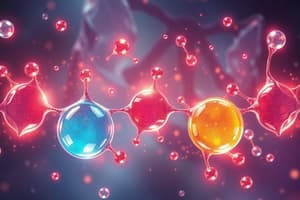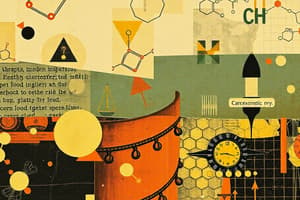Podcast
Questions and Answers
Which factor primarily affects the reactivity of carboxylic acids and their derivatives?
Which factor primarily affects the reactivity of carboxylic acids and their derivatives?
- The electronegativity of the substituent
- The overall stability of the molecule
- The basic strength of the acyl-bound substituent (correct)
- The steric hindrance around the carbonyl group
What is required to improve the efficiency of amide bond formation from a carboxylic acid?
What is required to improve the efficiency of amide bond formation from a carboxylic acid?
- Addition of a strong acid catalyst
- Use of an unactivated acid
- Increased steric hindrance
- Heating to a temperature greater than 160 °C (correct)
Which statement about the hydrolysis of amides is true?
Which statement about the hydrolysis of amides is true?
- Amides only hydrolyse under acid catalysis (correct)
- Amides are more reactive than esters in hydrolysis reactions
- Amides can be hydrolysed without the addition of water
- Amides undergo hydrolysis in both acid and base conditions
What major product is formed during the hydrolysis of esters?
What major product is formed during the hydrolysis of esters?
Why are amides considered more stable than esters?
Why are amides considered more stable than esters?
What role does sodium hydroxide play in the saponification process?
What role does sodium hydroxide play in the saponification process?
During amide bond formation, what is the consequence of the amine acting as a base?
During amide bond formation, what is the consequence of the amine acting as a base?
What is the typical temperature required for successful amide synthesis?
What is the typical temperature required for successful amide synthesis?
Which of the following groups is considered the most basic?
Which of the following groups is considered the most basic?
What is the primary product of the esterification of salicylic acid with acetic anhydride?
What is the primary product of the esterification of salicylic acid with acetic anhydride?
How are morphine and heroin structurally related?
How are morphine and heroin structurally related?
Which of the following correctly describes the reactivity of carboxylic acids?
Which of the following correctly describes the reactivity of carboxylic acids?
What is the impact of salicylic acid's high acidity when ingested?
What is the impact of salicylic acid's high acidity when ingested?
Which compound is NOT derived from the opiate family?
Which compound is NOT derived from the opiate family?
What type of reaction involves converting an amide into its corresponding carboxylic acid?
What type of reaction involves converting an amide into its corresponding carboxylic acid?
What is the significance of variations in the structures of morphine, heroin, and codeine in medicinal chemistry?
What is the significance of variations in the structures of morphine, heroin, and codeine in medicinal chemistry?
Which functional group is primarily involved in nucleophilic substitution reactions at a carbonyl group?
Which functional group is primarily involved in nucleophilic substitution reactions at a carbonyl group?
What is the role of acetic acid in the synthesis of heroin from morphine?
What is the role of acetic acid in the synthesis of heroin from morphine?
What effect does increasing the length of the carbon chain have on the solubility of carboxylic acids in water?
What effect does increasing the length of the carbon chain have on the solubility of carboxylic acids in water?
Which of the following statements regarding the reactivity of carboxylic acids is correct?
Which of the following statements regarding the reactivity of carboxylic acids is correct?
What is the pKa value of acetic acid and what does it indicate about its dissociation?
What is the pKa value of acetic acid and what does it indicate about its dissociation?
How does hydrolysis of amides differ from that of carboxylic acids?
How does hydrolysis of amides differ from that of carboxylic acids?
In medicinal chemistry, which characteristic of carboxylic acids contributes to their therapeutic efficacy?
In medicinal chemistry, which characteristic of carboxylic acids contributes to their therapeutic efficacy?
How does the boiling point of esters generally compare to that of carboxylic acids?
How does the boiling point of esters generally compare to that of carboxylic acids?
Which statement correctly describes the solubility trend of esters in water?
Which statement correctly describes the solubility trend of esters in water?
What is the main functional group present in amides?
What is the main functional group present in amides?
Which of the following correctly describes the naming convention for amides?
Which of the following correctly describes the naming convention for amides?
Which of the following is a characteristic feature of esters?
Which of the following is a characteristic feature of esters?
Amides are said to be typically which state of matter?
Amides are said to be typically which state of matter?
In the esterification process, which group in carboxylic acids is replaced to form esters?
In the esterification process, which group in carboxylic acids is replaced to form esters?
What type of bond is primarily responsible for the properties of amides?
What type of bond is primarily responsible for the properties of amides?
What is a characteristic of the nitrogen in amides?
What is a characteristic of the nitrogen in amides?
In medicinal chemistry, how might esters be utilized?
In medicinal chemistry, how might esters be utilized?
What characterizes the carbonyl group in carboxylic acids?
What characterizes the carbonyl group in carboxylic acids?
During the esterification process, what happens to the hydrogen in a carboxylic acid?
During the esterification process, what happens to the hydrogen in a carboxylic acid?
What is a common property of carboxylic acids compared to alkanes of similar size?
What is a common property of carboxylic acids compared to alkanes of similar size?
What characterizes the hydrolysis process of amides?
What characterizes the hydrolysis process of amides?
In medicinal chemistry, which property of esters makes them useful in drug design?
In medicinal chemistry, which property of esters makes them useful in drug design?
What is the main function of the carbonyl group in the reactivity of carboxylic acids?
What is the main function of the carbonyl group in the reactivity of carboxylic acids?
Which of the following correctly describes a ketone structure?
Which of the following correctly describes a ketone structure?
How do the boiling points of esters compare to those of similar-sized alkanes?
How do the boiling points of esters compare to those of similar-sized alkanes?
Which functional group is part of the amide structure?
Which functional group is part of the amide structure?
What structural feature allows carboxylic acids to form hydrogen bonds?
What structural feature allows carboxylic acids to form hydrogen bonds?
Flashcards are hidden until you start studying
Study Notes
Carboxylic Acids
- Carboxylic acids are organic compounds with a carboxyl group (-COOH)
- Many carboxylic acids are colorless liquids with unpleasant odors
- Carboxylic acids with 5 to 10 carbon atoms have a characteristic "goaty" odor
- Acids with more than 10 carbon atoms are wax-like solids
- Carboxylic acids exhibit strong hydrogen bonding between molecules
- Therefore, they have high boiling points compared to compounds of comparable molar mass
- Carboxylic acids are named by replacing the suffix (-e) with -oic acid
- Carboxylic acids are typically weak acids
- They partially dissociate in water to form H+ ions and RCOO- anions
- Acetic acid has a pKa of 4.76 in water meaning that in a 1.0 M solution, about 0.4% of the acid groups will be dissociated to form the carboxylate.
Esters
- Esters are colorless and volatile liquids with pleasant odors
- They have distinctive fruit-like odors and many occur naturally in essential oils of plants
- Esters are derived from carboxylic acids
- The -OH group of the carboxylic acids is converted to an -OR in an ester
- Esters have lower boiling points than carboxylic acids due to the lack of hydrogen bonding
- Small esters are fairly soluble in water, but solubility decreases with increasing chain length
- Esters consist of two words: the name of the alkyl group R' of the ester group ending with -yl, followed by the name of the parent acid with the family-name ending -ic acid replaced by -ate
Amides
- Compounds with a nitrogen directly attached to the carbonyl carbon are called amides
- The nitrogen of an amide may be unsubstituted (-NH2), monosubstituted (-NHR), or disubstituted (-NR2)
- Amides are typically solids, with the exception of formamide (HCONH2) which is a liquid
- Amides are not basic like amines
- Amides with an unsubstituted —NH2 group are named by replacing the -ic acid or -oic acid of the corresponding carboxylic acid with -amide
- If the nitrogen atom has alkyl substituents, the compound is named by specifying the alkyl group and then identifying the amide name
- The alkyl substituents are preceded by the letter "N" to identify them as being attached directly to nitrogen
Reactions of Carboxylic Acids
- Ester synthesis: The conversion of carboxylic acids to esters using acid and alcohol is called the Fischer Esterification
- Amide synthesis: The amide bond can be synthesized from a carboxylic acid and an amine
- This reaction does not proceed easily because the amine is a base and will deprotonate the acid
- Heating to a high temperature (typically >160 °C) is required to form the amide product
- Hydrolysis of esters and amides: Esters and amides can be hydrolyzed to yield back the parent carboxylic acid and corresponding alcohol or amine.
- The equilibrium of this reaction can be pushed towards the acid by adding an excess of water
- The most well-known hydrolysis reaction is saponification, in which triglycerides (fats) are reacted with sodium hydroxide to yield fatty acids and glycerol
- Amides are considerably more stable than esters and can only undergo hydrolysis in acid-catalyzed reactions
- The reactivity of carboxylic acids and their derivatives depends on the basic strength of the acyl-bound substituent.
Applications of Carboxylic Acids
- Salicylic acid: It is an organic carboxylic acid derived from the metabolism of salicin produced in willow bark
- Acetyl Salicylic Acid (Aspirin): It is produced by the esterification of salicylic acid with acetic anhydride
- Opiates: Morphine, heroin, and codeine are all examples of drugs from the opiate family
- Heroin: Morphine is esterified with acetic acid to yield heroin
- Codeine: An opiate where the ester is replaced by an ether
Studying That Suits You
Use AI to generate personalized quizzes and flashcards to suit your learning preferences.




